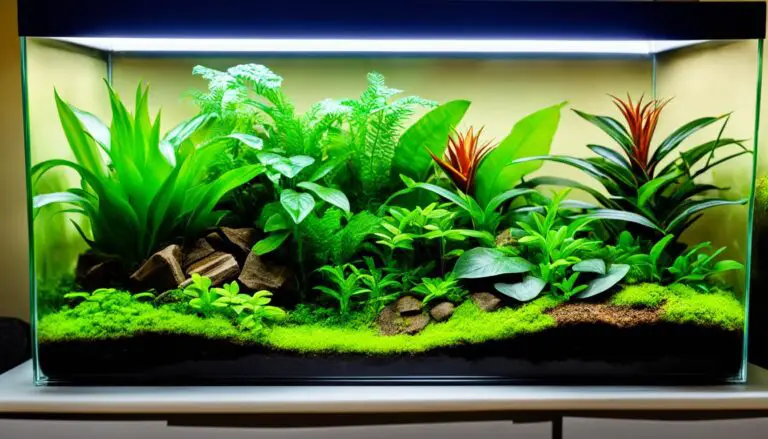Exotic Pet Housing for Reptiles: The Complete Guide
Are you looking for the perfect housing for your exotic pet reptiles? Look no further! This comprehensive guide will provide you with all the essential information you need on reptile enclosures, reptile terrariums, lizard habitats, and snake cages. Whether you have a leopard gecko, a ball python, or a bearded dragon, we’ve got you covered with expert tips and advice.
Key Takeaways:
- Learn about different types of enclosures such as reptile terrariums and lizard habitats.
- Understand the importance of reptile lighting and temperature control for creating a suitable habitat.
- Discover common health issues in reptiles and how to ensure their well-being.
- Explore commercial and custom enclosure options for your pet reptiles.
- Gain insights into handling, socialization, breeding, and first aid for reptiles.
Creating a Suitable Reptile Habitat
To ensure the well-being of your pet reptiles, it is crucial to create a suitable habitat that mimics their natural environment. Different reptile species have unique habitat requirements, including specific temperature control and reptile lighting needs. By understanding your reptile’s species-specific requirements, you can create a habitat that promotes their overall health and happiness.
Habitat Requirements
Each reptile species has its own specific habitat requirements that need to be met in order for them to thrive. These requirements can vary greatly depending on the reptile’s natural habitat, activity level, and overall size. Some reptiles, such as snakes, may require a more confined space, while others like lizards may need a larger enclosure to allow for more movement.
Temperature Control
Temperature control is essential for reptiles, as they are ectothermic creatures, relying on external heat sources to regulate their body temperature. Maintaining a proper temperature gradient within the enclosure is crucial to mimic their natural environment and allow them to thermoregulate effectively. This can be achieved by providing a heat source, such as heat lamps or under-tank heaters, as well as a cool area for the reptile to retreat to when needed.
Reptile Lighting
Proper reptile lighting is crucial as it helps provide the necessary UVB radiation that reptiles need to synthesize vitamin D3, which is crucial for proper calcium absorption and overall bone health. Depending on the reptile species, specific lighting requirements may vary, with some reptiles requiring more UVB exposure than others. Providing a UVB light source, such as a quality reptile UVB bulb, is essential to meet their lighting needs.
Creating a suitable habitat for your pet reptiles involves careful consideration of their unique habitat requirements, appropriate temperature control, and the provision of proper reptile lighting. By mimicking their natural environment, you can ensure your reptiles live a happy and healthy life.
Reptile Lighting and Temperature Control
Proper lighting and temperature control are crucial for creating a suitable habitat for your reptiles. This section will cover the importance of UVB lighting, the significance of maintaining a temperature gradient, and the essential tools you’ll need, including heat lamps and thermometers.
UVB Lighting: Mimicking Natural Sunlight
Reptiles require UVB lighting to mimic natural sunlight and provide them with essential ultraviolet radiation. This is vital for their overall health and well-being. UVB lighting aids in the synthesis of vitamin D3 in reptiles, which is essential for calcium metabolism and proper bone development.
When setting up the lighting in the enclosure, it’s important to consider the wattage and placement of the UVB bulbs. Make sure that the bulbs are within the appropriate distance from your reptile to ensure they receive the necessary UVB exposure. Regularly check the bulbs and replace them according to the manufacturer’s guidelines to maintain optimal UVB output.
Maintaining a Temperature Gradient
Temperature control is crucial for regulating your reptile’s body temperature and metabolism. Reptiles are ectothermic, meaning they rely on external sources of heat to regulate their body temperature. To achieve this, it’s important to create a temperature gradient within the enclosure.
The temperature gradient refers to the variation in temperature across different areas of the enclosure. This allows your reptile to move between warm and cool zones as needed. Providing a gradient enables them to thermoregulate effectively, helping to promote their overall health.
Heat Lamps and Thermometers: Essential Tools
Heat lamps are essential for creating the warm side of the temperature gradient. They provide a concentrated source of heat that allows your reptile to bask and raise their body temperature. Different heat lamps are available, such as ceramic heat emitters or basking bulbs, depending on the specific needs of your reptile species.
Thermometers are crucial for monitoring the temperatures within the enclosure accurately. They help you ensure that the temperature gradient is within the appropriate range for your reptile’s species. Place thermometers in different areas of the enclosure to ensure you have an accurate measure of the temperature gradient.
| Type of Lighting | Benefits |
|---|---|
| UVB Lighting |
|
| Heat Lamps |
|
| Thermometers |
|
In conclusion, proper lighting and temperature control are essential for creating a suitable reptile habitat. Providing UVB lighting mimics natural sunlight and promotes reptile health. Establishing a temperature gradient through the use of heat lamps and thermometers allows reptiles to thermoregulate effectively. By incorporating these elements into your reptile’s enclosure, you can ensure their overall well-being and happiness.

Ensuring Reptile Health and Well-being
Ensuring the health and well-being of your pet reptiles requires regular check-ups, proper handling, and awareness of common health issues. By prioritizing these factors, you can provide the best care for your scaly friend.
Regular Check-ups: A Preventative Measure
Just like humans, reptiles benefit from regular vet visits. These check-ups allow for early detection and treatment of any health issues before they escalate. By scheduling routine examinations, you can ensure that your reptile receives the necessary vaccinations, parasite control, and overall health assessments.
Proper Handling: Minimizing Stress and Injury Risks
When it comes to handling reptiles, it’s crucial to use proper techniques to minimize stress and prevent injuries. Here are a few tips:
- Approach with care: Approach your reptile calmly and gently to avoid startling them.
- Safety first: Always wash your hands before and after handling to prevent the spread of bacteria or infections.
- Support their weight: Reptiles rely on a secure and even distribution of weight. Be mindful of their fragile limbs and spine while handling.
- Mind the escape: Keep a close eye on your reptile to prevent any sudden escape attempts.
Common Health Issues: Be Aware and Seek Prompt Care
While reptiles can be resilient, they are prone to certain health issues. It’s important to be aware of these common ailments, which may include mites or ticks, respiratory infections, and metabolic bone disease. Recognizing the signs early on and seeking immediate veterinary attention can make a significant difference in your reptile’s well-being.
To learn more about common reptile health issues, consult the table below:
| Common Health Issues in Reptiles | Signs and Symptoms | Treatment |
|---|---|---|
| Mites or Ticks | Excessive scratching, scabs, visible mite infestation | Veterinary treatment: Parasite control, topical solutions |
| Respiratory Infections | Lethargy, wheezing, difficulty breathing, discharge from nose or mouth | Veterinary treatment: Antibiotics, nebulization therapy |
| Metabolic Bone Disease | Weakening of bones, trembling, muscle weakness | Veterinary treatment: Calcium and vitamin D supplementation, UVB lighting |
Remember, proactive care and prompt veterinary attention are essential for maintaining your reptile’s health and well-being.
Reptile Handling Tips
When it comes to handling reptiles, it’s important to follow certain guidelines to ensure your safety and the well-being of the reptile. Whether you’re a beginner or an experienced reptile owner, these tips will help you handle your pet reptiles with care and confidence.
Handwashing: Prevent the Spread of Bacteria
Before and after handling your reptile, always remember to wash your hands thoroughly. This simple act can help prevent the spread of bacteria and potential illnesses to both you and your pet. Use warm water and antibacterial soap, making sure to clean all areas of your hands, including between your fingers and under your nails.
Gentle Approach: Avoid Startling the Reptile
Approaching your reptile gently is crucial for their comfort and safety. Sudden movements or loud noises can startle reptiles and cause them stress. Instead, approach them calmly and slowly. This allows the reptile to acclimate to your presence and feel more secure during handling.
Proper Support: Supporting Reptile’s Weight
When picking up or holding your reptile, it’s important to provide proper support to prevent injuries. Different reptiles have different body structures, so make sure to research the appropriate handling technique for your specific reptile. Support their body and limbs carefully, ensuring their weight is evenly distributed. Avoid putting excessive pressure on their delicate bodies.
Escape Prevention: Be Aware and Vigilant
Reptiles are naturally curious and agile creatures, capable of surprising maneuvers. To prevent escape attempts, always handle your reptile in a secure and controlled environment. Be aware of their behavior during handling, especially if they show signs of agitation or restlessness. Ensure enclosures and handling areas are escape-proof, reducing the risk of your reptile getting loose.
By following these reptile handling tips, you’ll create a safe and positive experience for both you and your pet. Remember to prioritize handwashing, approach your reptile gently, provide proper support, and be vigilant to prevent escape attempts. These practices will help you build a bond of trust and ensure the well-being of your exotic pet reptiles.

Common Reptile Health Issues
Reptiles, like any other pets, are prone to certain health issues that can negatively impact their well-being. As a responsible reptile owner, it’s crucial to be aware of these common health problems and take appropriate measures to address them promptly. In this section, we will discuss three prevalent health issues that reptiles may face: mites or ticks, respiratory infections, and metabolic bone disease.
Mites or Ticks
Mites or ticks are common external parasites that can infest reptiles’ skin and cause significant discomfort. These tiny arthropods can be introduced to your reptile through various sources, such as contaminated bedding or infected enclosure mates. When infested, reptiles may exhibit excessive scratching, scabs, and irritation.
To address mite or tick infestations, it’s essential to consult with a veterinarian who specializes in reptile care. They can provide appropriate treatment options, which may include topical treatments, medication, or environmental changes to prevent reinfestation.
Respiratory Infections
Respiratory infections are a common health issue in reptiles, affecting their upper and lower respiratory tracts. Reptiles with respiratory infections may display symptoms such as coughing, wheezing, labored breathing, nasal discharge, and lethargy.
Proper husbandry practices play a vital role in preventing respiratory infections. Maintaining appropriate temperature and humidity levels in the enclosure, providing adequate ventilation, and avoiding exposure to drafts are essential. If you suspect your reptile may have a respiratory infection, consult with a reptile veterinarian immediately for accurate diagnosis and treatment options.
Metabolic Bone Disease
Metabolic bone disease (MBD) is a common nutritional disorder seen in reptiles, particularly those with inadequate access to proper UVB lighting or a calcium-deficient diet. MBD can lead to skeletal deformities, weakness, trembling, and even fractures in severe cases.
To prevent metabolic bone disease, it’s crucial to provide reptiles with adequate UVB lighting, a well-balanced diet supplemented with calcium and other essential nutrients, and proper temperature gradients within their enclosure. Regular veterinary check-ups can help identify early signs of MBD and ensure appropriate intervention.
| Common Reptile Health Issues | Symptoms | Treatment |
|---|---|---|
| Mites or ticks | Excessive scratching, scabs, irritation | Topical treatments, medication, environmental changes |
| Respiratory infections | Coughing, wheezing, labored breathing, nasal discharge, lethargy | Consultation with a reptile veterinarian, accurate diagnosis, treatment options |
| Metabolic bone disease | Skeletal deformities, weakness, trembling, fractures | Adequate UVB lighting, balanced diet with calcium supplementation, temperature management |
It’s important to note that the guidance provided in this section is general in nature and should not replace professional veterinary advice. If you suspect your reptile may be suffering from any health issue, it is best to consult with a qualified reptile veterinarian for an accurate diagnosis and tailored treatment plan.
Commercial and Custom Enclosures
When it comes to providing a suitable enclosure for your reptile, you have a variety of options to consider. While aquarium-type enclosures are commonly used, they may not always meet the specific needs of reptiles. This section will explore alternative choices, such as wooden enclosures and melamine/pressboard enclosures, which offer the flexibility to customize the habitat according to your reptile’s requirements.
While aquarium-type enclosures are popular due to their visibility and ease of setup, they may not always provide the necessary space and features that reptiles need. Wooden and melamine/pressboard enclosures offer the advantage of customization, allowing you to create an environment that suits your reptile’s unique needs.
The Benefits of Wooden Enclosures
Wooden enclosures provide a natural and aesthetically pleasing habitat for your reptile. They can be customized with different types of natural substrates, climbing structures, and hiding spots, creating an environment that closely resembles their natural habitat. Additionally, wooden enclosures offer better insulation and can help maintain the optimal temperature and humidity levels for your reptile.
The Versatility of Melamine/Pressboard Enclosures
Melamine and pressboard enclosures are another popular choice among reptile owners. These enclosures are highly customizable and offer the flexibility to incorporate various features such as heat gradients, UVB lighting, and specialized heating elements. Melamine and pressboard enclosures are easy to clean and maintain, making them a practical option for reptile owners.
“Wooden and melamine/pressboard enclosures provide the flexibility to create a habitat that meets the unique needs of your reptile.”
When choosing between commercial and custom enclosures, it’s important to consider the specific requirements of your reptile species. Factors such as ventilation, temperature control, and size should be taken into account when selecting the enclosure. Consulting with a reptile expert or veterinarian can provide valuable guidance in choosing the right enclosure for your beloved pet.
| Type of Enclosure | Advantages |
|---|---|
| Aquarium-type enclosures |
|
| Wooden enclosures |
|
| Melamine/Pressboard enclosures |
|
Determining Enclosure Size
The size of the enclosure is crucial for the well-being of your reptile. Different reptiles have different space requirements, and it’s important to provide enough room for them to move around, thermoregulate, and access microclimates. Below are some guidelines for determining the appropriate enclosure size for lizards, snakes, and aquatic turtles:
Lizard Enclosure Dimensions
When determining the enclosure size for lizards, there are a few rules of thumb to keep in mind:
- For small lizards (such as geckos), provide a minimum enclosure size of 10-20 gallons.
- For medium-sized lizards (such as bearded dragons or iguanas), opt for a larger enclosure of at least 40-60 gallons.
- Large lizards (such as monitor lizards) require even more space, so aim for enclosures that are 100 gallons or larger.
Snake Enclosure Dimensions
When it comes to snake enclosures, consider the length and activity level of the snake:
- For small or juvenile snakes, a 20-30 gallon enclosure should suffice.
- Medium-sized snakes may require a 40-60 gallon enclosure.
- Large or active snakes will need even more space, with enclosures ranging from 80-100 gallons or more.
Turtle Enclosure Dimensions
Aquatic turtles have specific space requirements due to their semi-aquatic nature. Consider the following dimensions:
- For small turtles, a 20-30 gallon tank is suitable.
- Medium-sized turtles may require a 40-60 gallon tank.
- Large turtles, such as the red-eared slider, will need a much larger tank—aim for at least 75-125 gallons, if not more.
Remember, these are general guidelines, and it’s always best to research the specific needs of your reptile species and consult with experts to ensure you provide adequate space for their well-being.
“The size of the enclosure plays a vital role in the physical and mental well-being of reptiles. Providing enough space allows them to engage in natural behaviors and creates a more enriching environment for their overall health.”
| Reptile | Minimum Enclosure Size |
|---|---|
| Lizards (small) | 10-20 gallons |
| Lizards (medium) | 40-60 gallons |
| Lizards (large) | 100 gallons or larger |
| Snakes (small/juvenile) | 20-30 gallons |
| Snakes (medium) | 40-60 gallons |
| Snakes (large/active) | 80-100 gallons or larger |
| Turtles (small) | 20-30 gallons |
| Turtles (medium) | 40-60 gallons |
| Turtles (large) | 75-125 gallons or larger |
Handling and Socialization Techniques
Building a bond with your reptile through bonding with reptiles handling and socialization is crucial for their well-being and your relationship with them. It is important to know the safe handling techniques that ensure both your safety and the reptile’s comfort. Here are some socialization tips and guidelines for handling your reptile companion:
1. Start Slow and Gentle
When handling your reptile, it is essential to approach them with patience and a gentle touch. Sudden movements or rough handling can cause stress and anxiety. Start by allowing them to get used to your presence and gradually introduce them to being handled. This gentle approach will help build trust and create a positive association with human interaction.
2. Provide Proper Support
Reptiles have delicate bodies, so it’s vital to provide proper support when handling them. Never grab or hold them by their tails, as this can cause harm. Instead, support their body underneath, ensuring they feel secure and comfortable in your hands. Supporting their weight will prevent them from feeling anxious or slipping out of your grasp.
3. Avoid Quick Movements
Reptiles are sensitive to sudden movements, which can startle them and trigger defensive responses. Avoid making quick movements or loud noises when handling your reptile. Move slowly and steadily, allowing them to adjust and feel more relaxed in your presence. A calm environment will promote a positive experience and help strengthen the bond between you and your pet.
4. Respect Their Boundaries
While handling your reptile is essential for socialization, it’s equally important to respect their boundaries. Pay attention to their body language and signs of discomfort, such as hissing, puffing up, or defensive postures. If your reptile displays these signs, it’s best to give them some space and try again later. Pushing boundaries can lead to stress and strain the bond you’re trying to build.
5. Regular Handling Sessions
To promote socialization, make regular handling sessions a part of your reptile’s routine. Start with short sessions and gradually increase the duration as your reptile becomes more comfortable. Be consistent with handling to develop familiarity and trust. Remember, each reptile is unique, so it’s essential to understand and respect their individual temperament and preferences.

“When handling your reptile, remember that patience, gentleness, and respect for their boundaries are key to building a bond with these unique creatures.” – Reptile Enthusiast
Summary
Proper handling and socialization techniques are essential for bonding with reptiles, ensuring their well-being, and fostering a strong relationship. By starting slow and gentle, providing proper support, avoiding quick movements, respecting their boundaries, and incorporating regular handling sessions, you can develop a deep connection with your reptile companion. Remember, each reptile has its own personality and preferences, so be patient and observant to create a positive and trusting bond.
Breeding and Reproduction
For those interested in breeding reptiles, understanding the basics of reptile reproduction is crucial. This section provides valuable insights and tips for successful breeding, along with specific information on crested gecko breeding.
Reptile reproduction involves various factors such as mating behaviors, environmental conditions, and egg incubation. By gaining a deeper understanding of these processes, reptile owners can enhance their chances of successful breeding.
Important Breeding Tips
Here are some essential tips to keep in mind when considering breeding reptiles:
- Research your reptile species: Each reptile species has its own unique breeding requirements. It’s important to thoroughly research your chosen species to ensure you can provide the ideal conditions for successful reproduction.
- Age and health: Ensure that your reptiles are at the appropriate age and in good overall health before attempting to breed them. Breeding too early or in poor health can have negative effects on the animals.
- Create a suitable breeding environment: Mimicking the natural habitat of your reptiles can encourage breeding behavior. This includes providing appropriate temperature and humidity levels, hiding spots, and suitable nesting materials.
- Introduce compatible partners: When breeding reptiles, it’s essential to select compatible individuals. This involves considering factors such as species, age, size, and temperament.
- Observe mating behaviors: Understanding the courtship and mating behaviors of your reptiles can provide insights into their breeding readiness. Observation allows you to identify optimal timing for introducing the male and female.
- Egg incubation: If successful mating occurs, proper egg incubation is crucial for the development of healthy offspring. Research the specific requirements for your reptile species and provide the necessary conditions to promote successful incubation.
- Seek professional advice: If you encounter difficulties or have specific questions about breeding your reptiles, consult with a reptile breeding expert or veterinarian who specializes in reptiles.
Remember that breeding reptiles requires careful thought and preparation. It’s essential to prioritize the well-being of the animals and ensure you have the necessary knowledge and resources to support successful reproduction.
| Reptile Breeding Checklist | Details |
|---|---|
| Research reptile species | Determine the specific breeding requirements of your chosen species |
| Ensure reptile health | Confirm that your reptiles are at the appropriate age and in good overall health before breeding |
| Create suitable breeding environment | Mimic the natural habitat with appropriate temperature, humidity, and nesting materials |
| Select compatible partners | Consider factors such as species, age, size, and temperament when choosing breeding partners |
| Observe mating behaviors | Learn to recognize courtship and mating behaviors to determine optimal breeding timing |
| Provide proper egg incubation | Research the specific requirements for your species and provide suitable conditions for incubation |
| Consult experts | Seek professional advice from reptile breeding experts or veterinarians for guidance and support |
With these breeding tips and a thorough understanding of reptile reproduction, you can embark on an exciting journey of breeding your exotic pet reptiles. Remember to always prioritize the health and welfare of your reptiles throughout the breeding process.
Reptile Health and First Aid
Regular veterinary examinations are vital for maintaining the health of your pet reptiles. Just like any other animal, reptiles can experience common health conditions that require proper care and attention. It’s important to be knowledgeable about these conditions and equipped with the necessary first aid skills to ensure the well-being of your reptile companion.
During veterinary examinations, a trained professional will assess your reptile’s overall health, check for any signs of illness or injury, and provide any necessary vaccinations. These examinations not only help prevent and detect health problems but also serve as an opportunity to ask questions and receive guidance on proper reptile care.
Common health conditions in reptiles can vary depending on the species, but there are several issues that owners should be aware of. These can include respiratory infections, metabolic bone disease, mites or ticks infestation, and more. Recognizing the signs and symptoms of these conditions is crucial for early intervention and effective treatment.
In addition to regular veterinary care, it’s essential to have basic first aid knowledge to handle emergency situations. Being prepared can make a significant difference in the outcome when your reptile is injured or becomes ill. Here are some general first aid tips:
- Stabilize the reptile: If your reptile has experienced an injury, it’s important to stabilize them to prevent further harm. Handle them gently and avoid excessive movements.
- Control bleeding: If your reptile is bleeding, use a clean cloth or gauze to apply light pressure to the affected area. Seek veterinary care promptly to address the bleeding.
- Administering first aid: Follow any specific first aid instructions provided by your veterinarian. This may include cleaning wounds, applying topical ointments, or providing oral medication.
- Provide a stress-free environment: When your reptile is unwell or injured, it’s crucial to create a quiet and calm environment to limit stress and promote healing.
Remember, first aid should only be used as a temporary measure until professional veterinary care can be obtained. Timely veterinary intervention is essential for the well-being of your reptile.
By prioritizing regular veterinary examinations, staying informed about common health conditions, and being prepared with first aid knowledge, you can ensure that your reptile receives the best possible care. Remember, each reptile is unique, so it’s essential to consult with a veterinarian who specializes in reptile health for personalized care and guidance.

Conclusion
Thank you for reading our comprehensive guide on exotic pet care for reptiles. By following the information and tips provided, you can ensure the health and happiness of your reptile companion. From creating a suitable habitat to regular check-ups and proper handling, every aspect plays a vital role in promoting their well-being.
Remember to provide a suitable habitat that mimics the reptile’s natural environment, including proper lighting and temperature control. Regular vet visits are crucial for preventive care and detecting any health issues early on. Handle your reptile with care, using gentle techniques and following safety measures to prevent any stress or injuries.
Ultimately, your dedication to your reptile’s well-being will contribute to their longevity and happiness. By nurturing a strong bond and providing the best possible care, you can enjoy a fulfilling relationship with your exotic pet. Should you encounter any concerns or queries regarding reptile health and care, always consult with a veterinarian for professional advice.
FAQ
What are the essential components of a suitable reptile habitat?
Why is UVB lighting important for reptiles?
How can I ensure proper temperature control in my reptile’s enclosure?
What are some common health issues in reptiles?
How should I handle my pet reptile?
What are some common health issues in reptiles?
What types of enclosures are suitable for reptiles?
How do I determine the appropriate enclosure size for my reptile?
How can I bond with my reptile and promote socialization?
What should I know about breeding reptiles?
Why are regular veterinary examinations important for reptiles?
What should I do in case of a reptile health emergency?
Source Links
- https://reptilesupershow.com/ultimate-guide-to-pet-reptile-care-essentials/
- https://www.anapsid.org/enclsize.html
- https://www.hamiltonplace.com/products/product/crested-geckos-the-ultimate-guide-on-how-to-care-for-your-pet-reptiles-including-breeding-interaction-lighting-feeding-housing-enclosure-tank-setup-behavior-habitat-and-health-maintenance-barnesnoble-28bb1e
Peter Stones is the founder of Exotic Pets Place, the leading online resource for exotic pet care information.
With over 10 years of hands-on exotic pet ownership experience, he is deeply passionate about sharing his expertise to help others properly care for their unusual pets.
When he's not writing extensively researched articles or connecting with fellow exotic pet enthusiasts worldwide, you can find Peter at home tending to his own beloved menagerie of exotic animals.

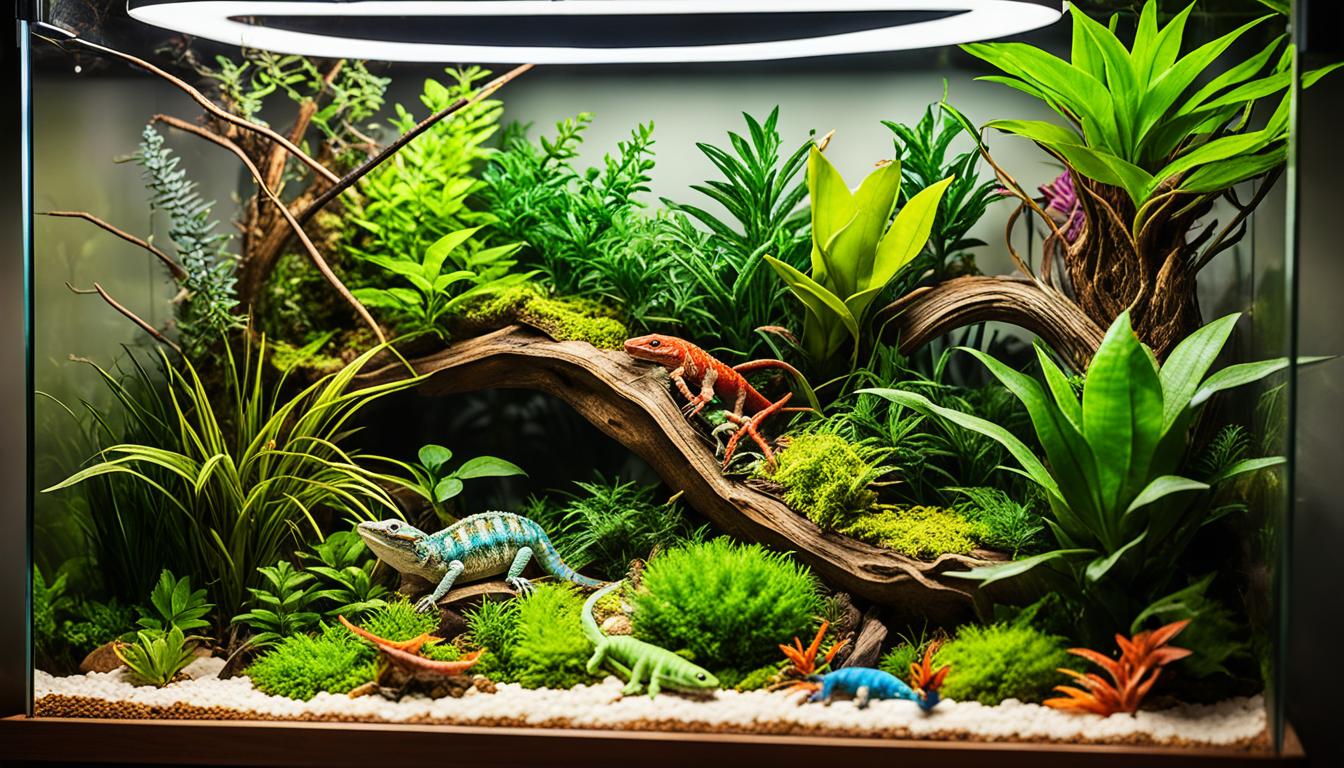
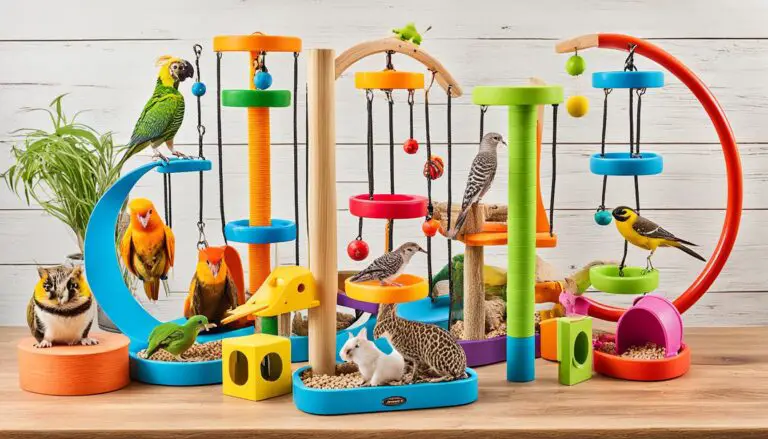

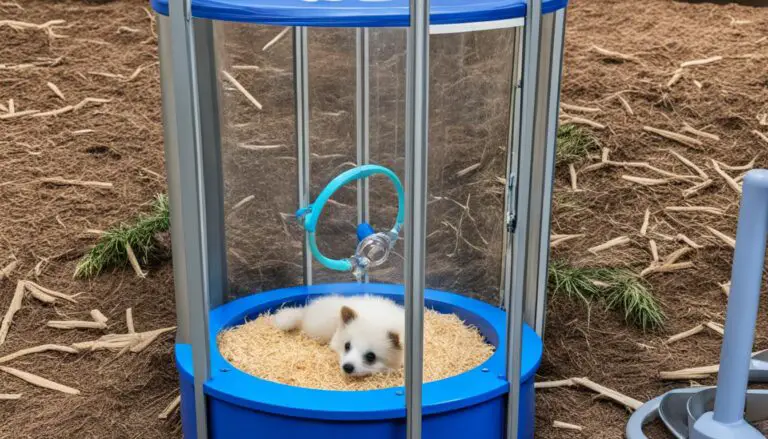
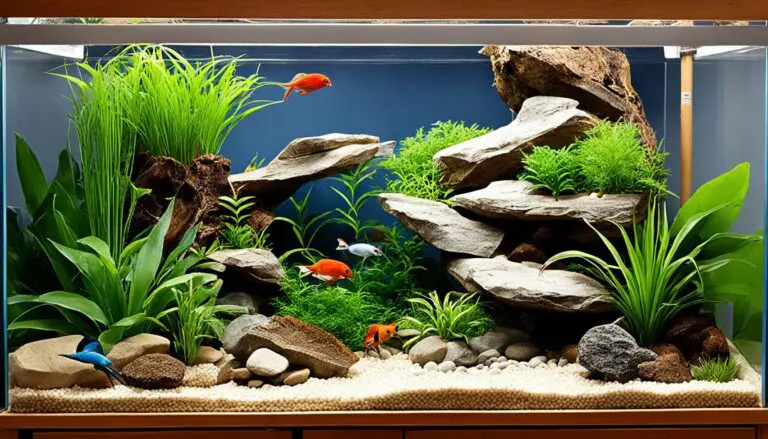
![How to Create a Safe Outdoor Space for Your Exotic Pet [Guide], wood house with a porch](https://exoticpetsplace.com/wp-content/uploads/2023/06/How-to-Create-a-Safe-Outdoor-Space-for-Your-Exotic-Pet-Guide-wood-house-with-a-porch-768x512.jpg)
